The Fingers
Many people are surprised to find that the fingers have such an important part to play in palmistry. Most people tend to think the subject is concerned only with the lines on the palm, not realizing that you can tell a great deal from a simple glance at the fingers. For instance, someone who displays his or her palms with the fingers held apart will be more open and confident than someone who holds his or her fingers together. It is a sign of caution and timidity when the fingers are held together. When the fingers are held slightly apart it is an indication that the person is a reasonably independent thinker.
I have already mentioned how I decide which cashier to line up behind from the length of that person’s fingers.
You already know something about the fingers. I explained in chapter 1 how long fingers denote patience and attention to details, while short fingers denote a faster, less detailed, and more impulsive approach.
Consequently, people with short fingers tend to become impatient with their longer-fingered colleagues because they like to jump in and get the job done as quickly as possible. They are enthusiastic and keen to start, but are not always as good at finishing. This is because their enthusiasm does not always last. They also frequently try to do too many tasks at the same time.
People with long fingers are virtually the opposite. They are patient and enjoy spending time thinking and planning about a task before commencing. They also like to take as much time as is necessary to successfully finish a task properly. They are conscientious, responsible, and methodical.
People with medium-length fingers combine the traits of the two extremes. Although they are usually responsible and conscientious, they might take shortcuts if the task does not appeal to them. They are usually patient, but might suffer from occasional outbursts of impatience.
Gaps Between the Fingers
How people hold their hands reveals a great deal about them. The gaps between the fingers are an extension of this. A noticeable gap between the first and second fingers, for instance, reveals someone who is confident and has good self-esteem. This person will stand up for what he or she believes in, and usually develops a strong faith or philosophy of life.
A noticeable gap between the second and third fingers is a sign of someone who lives for the moment, and has no concern or worry about what tomorrow will bring. This gap is extremely rare.
A noticeable gap between the ring and little finger is frequently found. This person is an independent thinker who likes to make up his or her own mind. It can also indicate someone who has problems in communication. This person may be able to talk confidently and at great length about matters that are not important, but will find it hard to express his or her emotions.
When the hand is held with all the fingers widely apart, the person is independent, carefree, friendly, and outgoing. He or she has nothing to hide.
When all the fingers are held together the person is cautious, reserved, and slow to make friends. This person is likely to constantly worry about what other people are thinking of him or her.
Ideally, we want a balance between having all the fingers held wide apart, and having them held together. A small space between each of the fingers indicates someone who is basically friendly, trusting, and independent in outlook.
The Fingertips
Fingertip shapes fit in well with d’Arpentigny’s system of hand classification. They are generally square, spatulate, or conic. Most people have a mixture of these on their hands. People like this are versatile, adaptable, and have a wide range of interests. However, even when people contain a mixture of different types of fingertips, one type will predominate. They are likely to use this characteristic in their careers, and utilize the others in hobbies and other interests.
People with square fingertips are down-to-earth, capable, practical conformists. They are cautious, conservative, and methodical. They like to take time to mull things over before making decisions. They prefer the tried and true, and tend to dislike change.
People with conic fingertips are easygoing, sensitive, quick-thinking, and idealistic. They work best in pleasant surroundings and enjoy beauty in all its forms. They enjoy mentally stimulating conversations, but usually act on their feelings, rather than logic.
Every now and again you will come across someone with pointed fingertips. This is an extreme form of the conic. People with pointed fingertips are intuitive, inspirational, high-strung, and impressionable. These people find life hard to deal with, and are happiest inside a close relationship. However, they are overly possessive and frequently stifle their partners with a constant need for attention.
People with spatulate fingertips (tips that flare at the ends) are practical, intelligent, unconventional, inventive people who love new concepts and ideas. These people enjoy change and become extremely enthusiastic about new and different ways of doing things. They need challenges and work best when self-employed.
You will sometimes find people with droplets on the tips of their fingers. When the palm is held facing downwards, droplets can be seen like tiny drops of water on the tips of the fingers. People with droplets on their fingers are extremely sensitive and highly intuitive. They are caring, supportive people with a great love for all living things.
The Phalanges
Each finger is divided into three sections, known as phalanges. The first, or nail, phalange relates to spirituality and intuition. Someone with long tip phalanges on each finger will be thoughtful and interested in the spiritual side of life.
The middle phalange relates to the person’s intellect. People with long middle phalanges are generally successful in business matters.
The base phalange relates to the material aspects of life. People with long, thick, puffy base phalanges are self-indulgent and have a strong desire for physical gratification.
Base phalanges that are slightly spongy to the touch indicate someone who likes food and is usually a good cook.
Strain and Stress Lines
Indications of strain and prolonged stress show up clearly on the fingers (figure 36). Fine, vertical lines on the base phalange are indications of strain. They mean that the person has been overdoing things and would benefit by having one or two days off. Even a good night’s sleep can affect these lines.
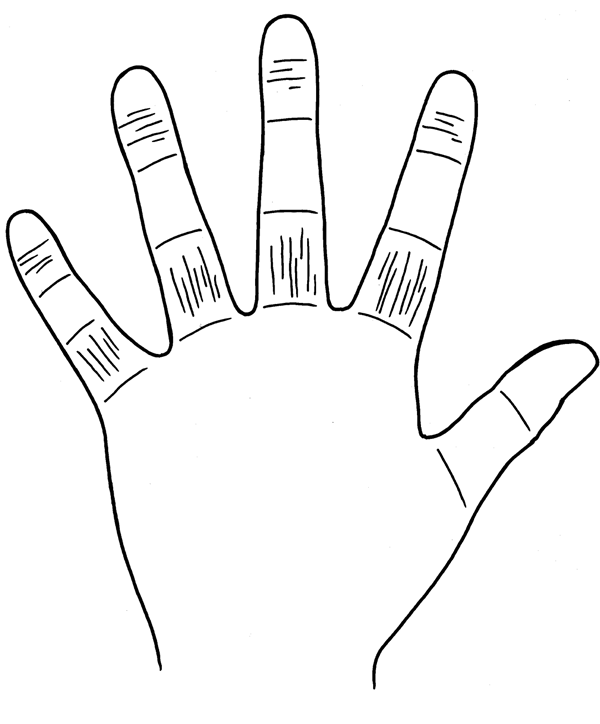
Figure 36: Stress and Strain Lines

Figure 36: Stress and Strain Lines
Much more serious than the strain lines are the stress lines. These are fine, horizontal lines on the first, or nail, phalange of the fingers. They reveal that the person has been suffering stress and strain over a long period of time. These lines take time to appear, and disappear just as slowly. Whenever I see these lines I suggest that the person take a vacation, or remove himself or herself from whatever situation is causing the stress. Of course, this may not be easy, particularly if the stress is caused by a relationship or work pressures.
If the stress continues, the stress lines move further down the fingers into the other phalanges. When this occurs, it is a sign that the person’s health is in danger of being affected as a result of the continued stress.
Straight and Crooked Fingers
Ideally, all of the fingers should be straight. When they curve towards the fingers on either side, it means that the person is subconsciously underrating himself or herself in the area indicated by the curved finger, and is gaining support from the other fingers.
Occasionally, you will find a little finger that appears to be twisted. You need to be careful with the interpretation of this since it can be an inherited trait. However, it can also be a sign of potential dishonesty. Be careful with any financial dealings you may have with these people. I have noticed this strange formation on the little fingers of many moneychangers at the railway stations in India.
Knotty and Smooth Fingers
Fingers are considered to be either smooth or knotty. Knotty fingers are those where the joints are extremely visible. People with knotty joints in their fingers like to analyze everything, taking very little on trust or face value. People with smooth fingers are more trusting and intuitive.
In my classes, I would have my students imagine ideas coming into the body through the fingertips. Every time these thoughts reached a knotty joint, they would go round and around in a process of examination and analysis before continuing. Consequently, ideas and thoughts enter the palms of smooth-fingered people much more quickly than they do with people with knotty joints. If you know someone who likes to analyze and discuss the smallest detail for hours on end, you can be sure that this person will have knotty fingers.
Not surprisingly, knotty joints are found frequently on the fingers of people with philosophical hands.
The knots between the first and second phalanges are known as the “knots of mental order.” People with these are logical, methodical, and mentally alert. They invariably act on logic rather than intuition.
The knots between the second and third phalanges are called “knots of material order.” These people overanalyze everything, and this can inhibit their creative potential. People who have knots of material order on their fingers almost always have an abundance of worry lines on their palms as well.
Setting of the Fingers
The fingers can be set on the hand in four different ways. The most usual formation is that of a gently curved arch, in which the first and fourth fingers are set slightly below the second and third fingers (figure 37). This denotes a well-balanced person who is fair, easy to get along with, and does not consider himself or herself superior or inferior to anyone else.
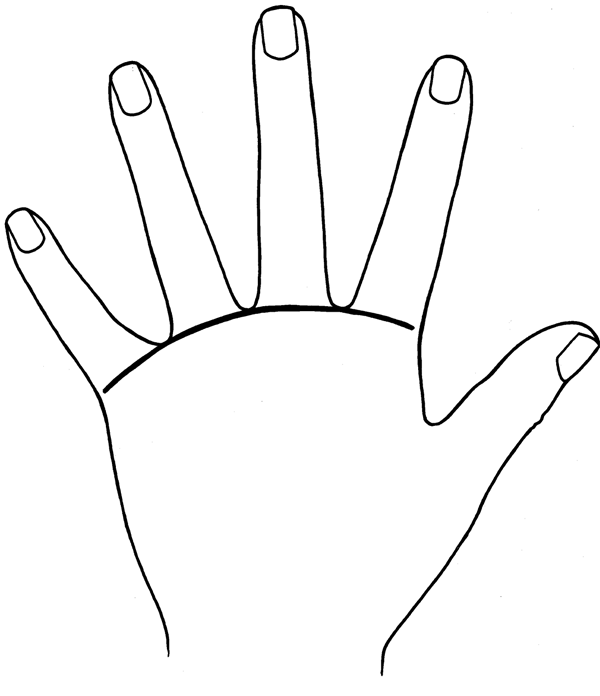
Figure 37: Fingers Set on a Curved Arch (Well-Balanced Person)

Figure 37: Fingers Set on a Curved Arch (Well-Balanced Person)
When the first and fourth fingers are set considerably lower than the second and third fingers we have what is known as a tented arch formation. People with this particular setting are lacking in confidence and have considerable doubts about their abilities. They lack self-esteem and feel that they are not in control of their own lives.
When the fingers are all arranged in a straight line we have someone who is confident and proud of his or her capabilities and achievements. If the first and second fingers are also equal in length this person will be vain, ruthless, arrogant, and condescending to others.
The “dropped” little finger is a setting that is frequently found today. It occurs when the first three fingers are set in a gentle curve, but the little finger is set considerably lower than the others (figure 38). This is an indication that the person will have to learn the hard way, usually through disappointments and setbacks. Everything will go well for a long time and then, usually quite suddenly, this person will find himself or herself in a difficult situation that will take a great deal of time and effort to resolve.
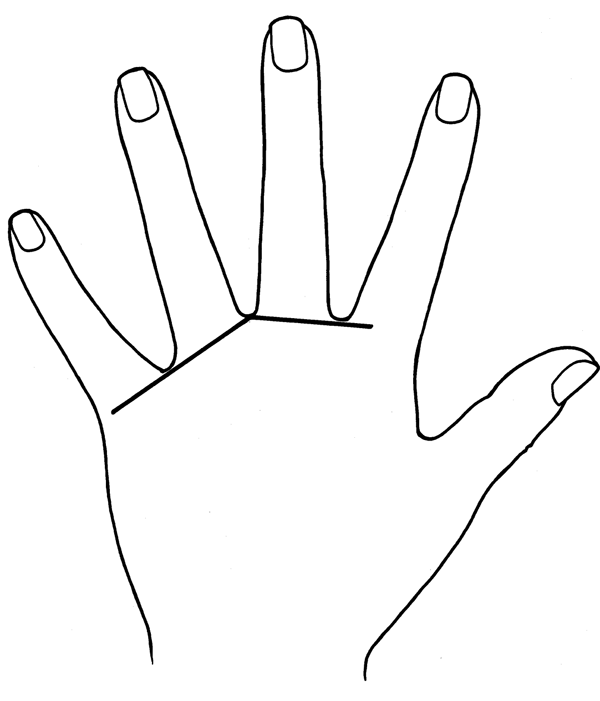
Figure 38: Fingers Set on a Tented Arch (Lack of Confidence)

Figure 38: Fingers Set on a Tented Arch (Lack of Confidence)
If the fingers are supple, the person will have a flexible mind. He or she will frequently act on intuition and will be open to all points of view. In extreme cases, where the fingers appear to be virtually double-jointed, the person will be excitable and love talking (usually about himself or herself).
Conversely, if the fingers appear hard and rigid, with no flexibility whatsoever, the person will also be rigid and fixed in his or her outlook and approach.
Fingernails
Subliminally, we all notice fingernails and make assessments based on their condition. We assume that someone with manicured fingernails will be refined and cultured, just as we assume the opposite about someone with dirty, broken, or uncut fingernails.
One of my regular customers at a bookstore I owned many years ago always tried to conceal her bitten nails when paying for her books. She was embarrassed about her nervous habit. However, what she found hardest to deal with was the fact that people immediately lowered their expectations of her as soon as they saw her nails. I encouraged her to visit a hypnotherapist to cure her of the habit. As soon as her fingernails grew, her self-esteem and confidence increased dramatically.
Fingernails vary greatly. Ideally, they should follow the shape of the finger.
The ideal fingernail is wide and medium in length. It should be slightly longer than it is wide. People with nails like this are energetic, faithful, and honest.
People with long fingernails are sensitive and emotional. They enjoy creative activities.
If the fingernails are narrow, as well as long, the person is inclined to be selfish and always wants to get his or her own way. Narrow fingernails are always a sign of a narrow-minded person who is fixed in his or her ways.
People with short fingernails are hard on themselves and suffer from nervous tension. They are impatient and inclined to be critical.
If the nail is short and narrow, and looks small compared to the fingertip, the person will be frugal, mean, and avoid spending money if it can possibly be avoided. This person takes pride in being parsimonious.
Vertical ridges on the fingernail can be caused by either a deficiency in the diet or extreme nervousness.
Horizontal ridges are caused by illness or stress at the time that the nail was first becoming visible.
White dots on the nails are caused by stress and anxiety. They can also indicate a calcium deficiency.
The color of the nails can also give a clue to the health of the person. The ideal nail appears pinkish in color and contains no ridges or white spots on it. Red fingernails belong to people who become overexcited or agitated very easily. A nail that appears white is likely to belong to someone who is anemic. Liver problems are indicated when the nails have a yellowish tinge. A blue tinge to the nails reveals circulation problems. If the nails have always had a bluish hue, the person is likely to be cold and unfriendly.
The Jupiter Finger
Keywords: ambition, independence, confidence, faith, and philosophy
The Jupiter finger is the first finger and denotes pride, ambition, leadership, and the ego. In palmistry we are always looking for balance. Consequently, we want this finger to be approximately the same length as the third finger (figure 39). It is usually easier to determine the relative lengths of the first and third fingers by looking at the back of the hand.
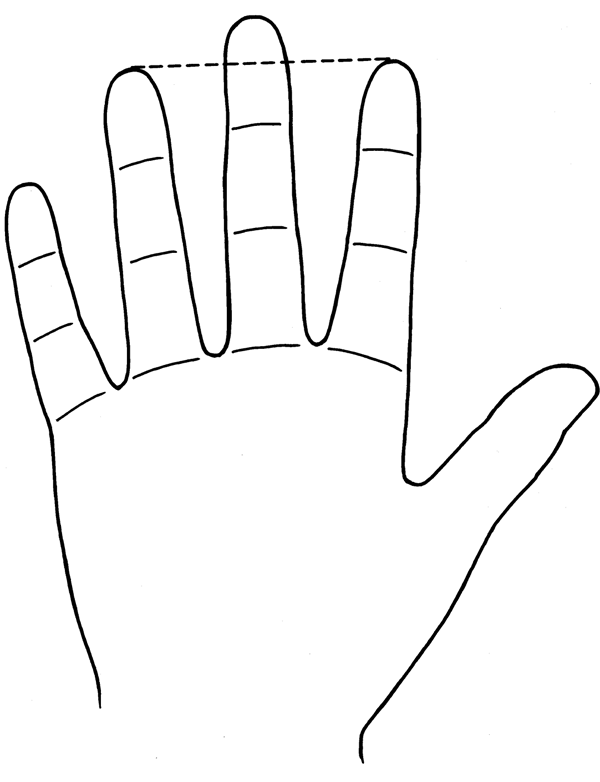
Figure 39: Jupiter Finger Same Length as Apollo Finger

Figure 39: Jupiter Finger Same Length as Apollo Finger
If the first finger is noticeably longer than the third finger, the person will be self-motivated and have a strong desire to be successful. In normal circumstances, this is a good quality. However, many people with this trait do not know when to stop, and push themselves into an early grave.
If the first finger is noticeably shorter than the third finger the person will lack confidence in early life. He or she will be inclined to hold back, rather than push forward. This means that in the growing up years this person can be pushed around by others, and will find it hard to stand up for himself or herself. However, in later life, a Jupiter finger that is shorter than the third one can be an advantage, since this person will know when to pause and relax, and when to push forward.
When the first and third fingers are roughly equal in length, the person will be reasonably ambitious, but will know when to pause and relax. He or she will be realistic in outlook and will not waste time pursuing unrealistic dreams.
The first finger should be straight. If it curves towards the second finger the person will be self-centered, self-pitying, and lacking in confidence. It is a sign of low self-esteem. He or she will need constant support and encouragement.
The phalanges should be approximately equal in length. If the tip phalange is the longest, the person will have strong religious or philosophical interests. He or she will enjoy working with others who think along similar lines.
If the middle phalange is the longest, the person will have a practical and positive approach towards life. He or she is likely to possess a keen intelligence.
The base phalange is the one that is most likely to be the longest on the Jupiter finger. This gives the person a strong interest in philosophy and religion. Some people with this combination take up the church as a career, but for most, it provides a questioning sort of faith that these people gradually build up and develop as they go through life.
You will sometimes see a Jupiter finger that has an extremely short base phalange. People with this on their hands are happiest when left to their own devices. They are modest, self-deprecating, and devoid of ambition.
The Saturn Finger
Keywords: responsibility, limitations, and common sense
The second finger is named after Saturn, the Roman god of agriculture. He was a rather gloomy god who gave his name to the word “saturnine.” Consequently, this finger relates to duty, service, restrictions, restraint, and common sense.
The second finger should be the longest finger on the hand. If it is too long, in comparison with the other fingers, the person will be happiest on his or her own, and will need very little contact with other people. If this finger is too short in comparison with the other fingers the person will lack any sense of responsibility. In practice, most people have Saturn fingers that are neither too long nor too short.
The Saturn finger should be straight. However, it is the finger that is most likely to curve one way or the other. If it curves towards the first (Jupiter) finger, the person will underrate himself or herself, and be overly deprecating and nervous. A curve in this direction is often a sign of an inferiority complex (especially when the Jupiter finger is shorter than the third finger).
If the Saturn finger curves over the third (Apollo) finger, the person will be holding himself or herself back creatively, and will need a great deal of encouragement from others. People with this formation are usually aware of their capabilities, but prefer to dabble, rather than run the risk of failing if they work too hard or take the task seriously.
The Saturn finger is often held close to one of the adjacent fingers when the hand is held open. This is known as a “finger cling.”
If the Saturn finger almost touches the third finger when the hand is held open, the person will have a strong interest in the arts and would be happiest working in some creative field.
If this finger almost touches the Jupiter finger it is a sign that the person will eventually be in an influential position in his or her career.
Of course, it also means something when the Saturn finger stands on its own and does not curve or cling to an adjacent finger. This is an indication that any influence the person manages to achieve will come from outside his or her career.
Naturally, we want the phalanges to be approximately equal in length. If the tip phalange is longer than the others, the person will be cautious, conservative, and proud of his intellect. He or she is likely to feel superior to people who are less well endowed. If the tip phalange is extremely long, at the expense of the other two phalanges, the person will be gloomy, sad, and melancholy—in fact, saturnine.
The middle phalange is the one that is most likely to be longest. This denotes someone who is a good organizer and enjoys detailed work. He or she will be conscientious and methodical. When the finger is smooth, without obvious joints, a long middle phalange gives an interest in the occult. If the middle phalange is extremely short, compared to the other two phalanges, the person will dislike work and will fritter his or her time away, and achieve little.
A long base phalange gives an interest in agriculture, which is probably why this finger was named after Saturn, the god of agriculture. People with this formation enjoy working with the soil, and make good gardeners, farmers, and people who enjoy being out of doors.
The Apollo Finger
Keywords: creativity, self-expression, and aesthetic sense
The third finger is known as the “Apollo” or “Sun” finger. It represents beauty, refinement, and creativity. An average length Apollo finger reaches halfway up the fingernail of the Saturn finger, and is about the same length as the Jupiter finger. If it is longer than this, the person will have an aesthetic, creative nature that needs to be expressed in some sort of way. If this finger is extremely long (almost the same length as the Saturn finger), the person will be reckless and take risky chances that most people would refuse. Often, this formation creates an interest in gambling.
Naturally, the Apollo finger should be as straight as possible. If it curves toward the Saturn finger it is an indication that the person has a creative talent that has been put to one side while the person focuses on something more mundane. You will find this formation on the hands of many creative people who are not able to make a living out of their creativity, and are forced to do other work.
When the Apollo finger curves toward the little finger it reveals that the person is subconsciously underrating his or her creative ability. An acquaintance of mine is a talented potter who is never satisfied with what he produces. Behind his pottery studio is a small mountain of discarded items that he feels are not good enough to sell. His Apollo finger has a pronounced curve toward the little finger.
It is usual for all the phalanges to be the same length on this finger. People with this combination enjoy nice things and work best in pleasant surroundings.
When the tip phalange is longer than the others the person will have high ideals, and frequently display a creative talent. Whenever I see a long tip phalange on this finger I immediately look at the person’s head line to see if it curves towards the wrist (indicating a good, creative imagination).
The second phalange is the one that is most likely to be the longest on the Apollo finger. It indicates natural good taste, and the ability to use it in a career. Someone with this formation would be brilliant at selling items that he or she personally found to be attractive, but would be unable to sell anything that he or she disliked.
It is unusual for the base phalange to be longer than the others. It indicates a totally materialistic approach to life with little interest in aesthetic or cultural activities. When they become successful these people like to surround themselves with expensive, often gaudy, objects to impress others.
The Mercury Finger
Keywords: communication, business and finance, and quick thinking
Mercury was the Roman messenger of the gods. Consequently, the fourth finger relates to communication. It is also related to commerce and sex.
An average length little finger reaches up to about the first joint of the third finger. The longer this finger is, the better the person is at communication. People with short little fingers find it hard to express themselves. If the finger is extremely short, the person will remain emotionally immature, and this will reveal itself in many different ways. It frequently reveals itself in relationship and sexual problems.
However, before assessing the length of the finger you have to see how it is set on the palm. As mentioned earlier, many people have a “dropped” little finger, and this may make the finger appear shorter than it actually is. In these instances, you have to mentally set this finger alongside the others to determine if it is short, long, or average in length.
It is important for this finger to be straight, since this is a sign of honesty. When it is bent or twisted, it shows that the person is potentially dishonest. A man who used to work at our local post office had a twisted little finger. I quickly discovered that I had to check my change after dealing with him, since it was never correct. Whenever I see a twisted little finger on someone’s hand, I stress the necessity of being careful and honest in all business dealings.
It is rare for the three phalanges on the Mercury finger to be even in length. The tip phalange is almost always the longest. Since this section governs verbal communication, this phalange is invariably long in people who make their livelihoods using their voice. Teachers, entertainers, and sales people are obvious examples.
When the tip phalange is short the person will find it hard to express himself or herself, and will appear shy and retiring.
The middle phalange is usually small. This section relates to written communication, and most people tend to avoid this whenever possible. People with large middle phalanges are good at expressing themselves with words on paper. They may not necessarily like doing it, but have a definite talent in this direction. You will find this formation on the hands of professional writers, of course, but you will also find it on people who are good at writing letters, or can express things more clearly by writing them down, rather than saying them out loud.
The base phalange relates to money, finance, and business. Someone with this formation will love money, and will be inclined to bend the truth when necessary to obtain it.
The Mercury finger sometimes curves towards the Apollo finger. This formation is known as the “finger of sacrifice,” and shows that the person will give up his or her own ambitions to help others. This formation is most likely to be found on the hands of caregivers, and people who are involved in the healing professions.
The Thumb
Keywords: logic, willpower, reasoning ability, independence, and vitality
The thumb plays an important role in palmistry. Many palmists, particularly in India, pay more attention to the thumb than any other part of the hand. This is because it clearly reveals the person’s character.
Only primates have opposing thumbs. Our thumbs contain a radial nerve that is made of the same nerve fiber that runs through our spinal columns and is also found in the middle of our brains. This radial nerve gives us the superior reasoning capabilities that enabled us to rise so far above the rest of the animal kingdom.
Speaking generally, the larger the thumb, the greater the degree of success the person will enjoy in life. Napoleon is believed to have had an extremely large thumb. Obviously, other factors need to be looked at, as well. Someone with a large thumb, but no motivation or energy, will not amount to much. However, the large thumb would still enable him or her to achieve much more than would have been the case if it had not been present.
People with large thumbs are generally motivated, persistent, and ambitious. They also have leadership qualities. All of this enables them to achieve their goals.
People with short thumbs are generally easygoing. They can be obstinate and stubborn on occasion, but lack will.
Most people have thumbs of average length. These reach at least halfway up the base phalange of the Jupiter finger. People with average thumbs can stand up for themselves when required and have a sense of fair play.
The setting of the thumb can sometimes make it hard to determine if it is short, medium, or long. When the thumb is set high up on the hand towards the fingers, the person will be original, outgoing, and adventurous. When the thumb is set low down towards the wrist the person will be cautious and think carefully before acting. Most people have thumbs that are set neither high nor low.
Most people’s thumbs are held at an angle of about forty-five degrees to the hand. This shows that they are reasonably broad-minded, but still conform to society’s expectations and standards. The wider the angle of the thumb, the more outgoing and generous the person will be. It can be an interesting exercise to watch people’s thumbs on television. You will find a large number of entertainers with a wide angle of the thumb.
People with a small angle of the thumb are inclined to be small-minded, selfish, and negative. They are usually concerned only with their immediate family and have little interest in anything else.
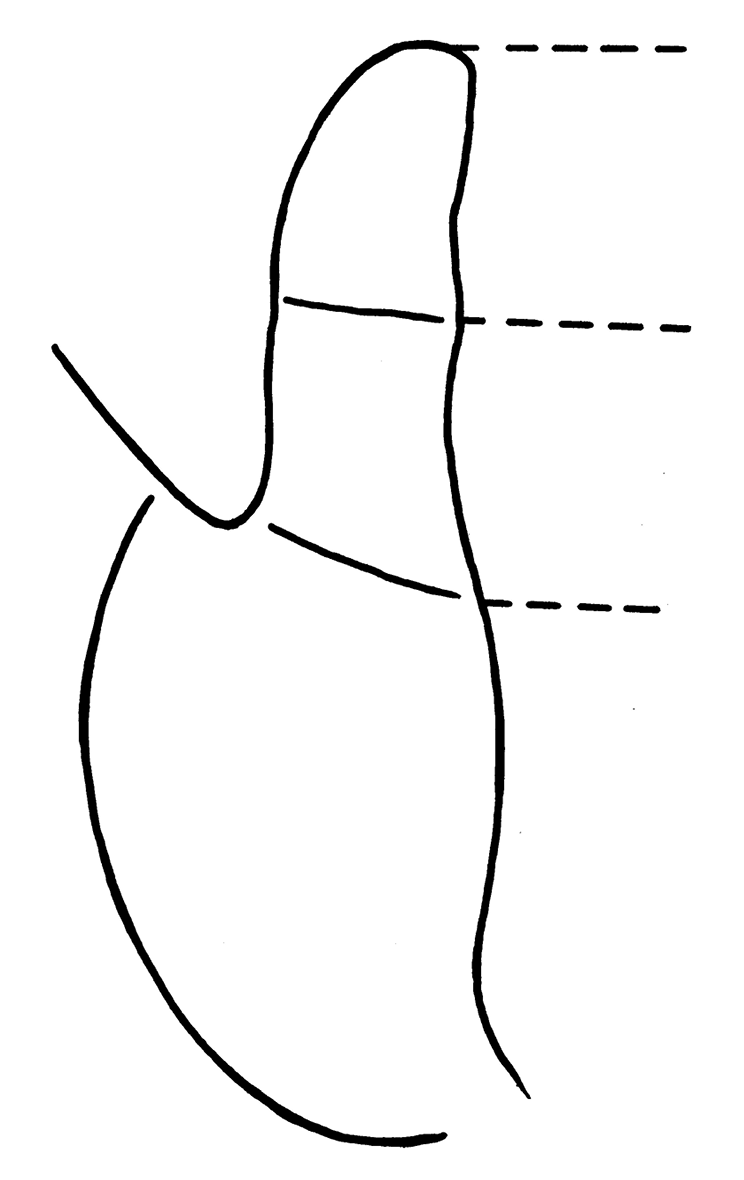
Figure 40: The Three Phalanges of the Thumb

Figure 40: The Three Phalanges of the Thumb
There are two angles, or bumps, that can be found on the thumb. The first of these is the angle of practicality, which is an angle, or bulge, on the outside of the thumb at the bottom of the second phalange. As its name indicates, people with this angle are good with their hands and often enjoy careers that are “hands on.” The larger the angle, the greater the practicality.
This angle is sometimes known as the “angle of time.” It does not necessarily mean punctuality, but someone with this formation will invariably be at the right place at the right time. This formation can be extremely useful to a comedian, for instance, because it will give him or her a good sense of timing.
Some people have no angle at this position. These people are not manually dexterous, and would do better in a field that utilized their heads more than their hands.
The other angle on the thumb is called the “angle of pitch.” It is found at the base of the thumb where it joins the wrist. This angle gives the person a good ear for music and a natural sense of rhythm.
Many entertainers have both of these angles on their thumbs. This means that they have a good sense of timing, a good ear for music, and a natural sense of rhythm.
The thumb is divided into three phalanges (figure 40). Two of these are obvious, but the third is not. It comprises the mound, or mount, immediately below the thumb that is encircled by the life line. This area is called the mount of Venus. We will be discussing the mounts in the next chapter.
The tip phalange represents willpower and the second phalange relates to logic. As we are looking for balance in palmistry, we want these two phalanges to be roughly equal in length. This gives the person an equal amount of willpower and logic. He or she will think first and will then act.
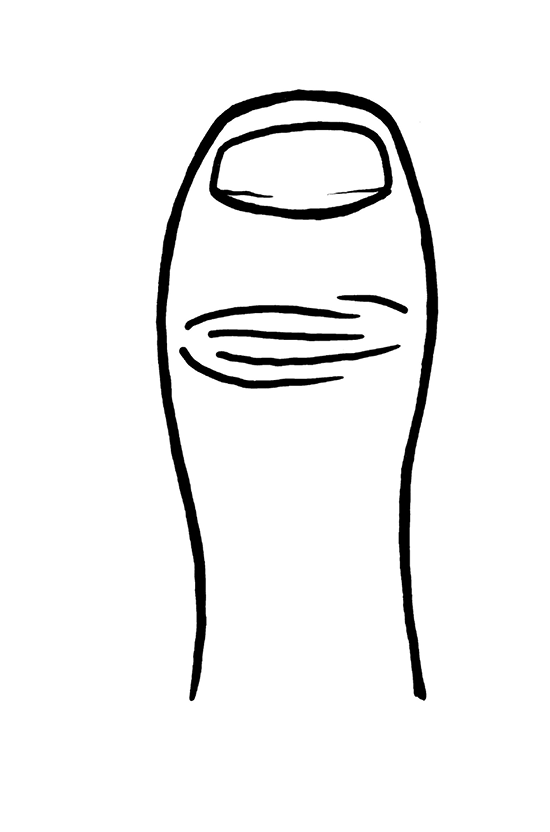
Figure 41: Murderer’s Thumb

Figure 41: Murderer’s Thumb
If the tip section (willpower) is longer than the second phalange (logic), the person will act without thinking the matter through. People with this formation make many mistakes as they go through life, but pick themselves up again each time, and keep on going. Often, they become extremely successful, since they do not know when to stop.
It is much more common to find people with a second (logic) phalange that is longer than the first. These people get plenty of ideas, but never quite get around to acting on them. They procrastinate and dream about all the great things they are going to do one day.
The tips of the thumb follow the system of hand shapes that d’Arpentigny devised one hundred and fifty years ago.
If the tip of the thumb is square in shape, the person will be down-to-earth, practical, capable, and have a strong sense of what is right and wrong.
If the tip is spatulate, the person will have an inventive mind and an inquisitive nature. He or she will always keep busy.
If the tip is conic, the person will be graceful, charming, and refined. A conic tip often belongs to a thumb that has a “waisted” second phalange. This means that the second phalange curves inwards on both sides and appears to have a waist. People with a waisted second phalange are diplomatic, caring, and tactful. If you know someone who can say “no” in such a gentle way that you are halfway down the street before you realize what he or she has said, you will know someone with a waisted second phalange.
If the tip appears to taper towards the end, the person will be a deep thinker, who can convey bad news in a gentle, caring manner.
If the tip is flat and broad, the person will be methodical and careful, deliberating at length before acting.
You will also occasionally come across what is known as the “murderer’s thumb.” The first phalange of this type of thumb appears to be a knob resting on top of the second phalange (figure 41). It indicates that the person will be tolerant and patient for a long while, but then something trivial will cause them to erupt in anger. This is probably the reason why this thumb gained its bad name. In fact, this type of thumb is usually inherited. Many years ago I read the palm of a man with “murderer’s thumbs,” and he told me that his father, grandfather, and infant son all had identical thumbs.
You will now understand that palmistry is much more than the lines on the palm. In the next chapter we are going to take everything a step further by looking at the mounts.